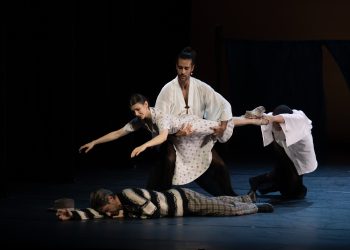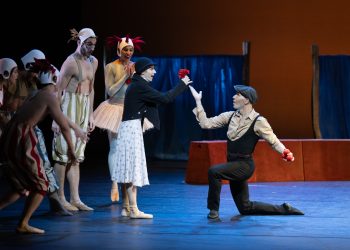 United Kingdom Natalia Horečná’s La Strada: ACWorkroom Ltd, Sadler’s Wells, London, 25.1.2024. (JO’D)
United Kingdom Natalia Horečná’s La Strada: ACWorkroom Ltd, Sadler’s Wells, London, 25.1.2024. (JO’D)

Creatives:
Choreography – Natalia Horečná
Music – Nino Rota
Set and Costume design – Otto Bubeníček
Lighting design – Andrea Giretti
Cast:
Gelsomina – Alina Cojocaru
Zampanò – Mick Zeni
Il Matto – Johan Kobborg
Angels – Marc Jubete, David Rodriguez
Artists – Yaiza Coll, Winnie Dias, Maria Tolstunova, Giulio Galimberti, Lukas Hunt, Robert Weithas
Taking its inspiration from Federico Fellini’s 1954 film of the same name, La Strada is the first full-length dance commission by former Principal of The Royal Ballet and English National Ballet, Alina Cojocaru. It tells the story of a ‘childlike’ girl, Gelsomina (Cojocaru), who is sold by her mother to a circus strong man, Zampanò (Mick Zeni). While travelling on the road as the latter’s assistant, Gelsomina meets tightrope walker, Il Matto (Johan Kobborg). Her subsequent fascination with him arouses Zampanò’s jealousy. A fight between the two men results in Il Matto’s death.
Although using music that Nino Rota composed for La Strada and for other films by Fellini, choreographer Natalia Horečná makes it clear in the programme notes that, ‘We are not mimicking the Gelsomina of the movie … we work with the people we have in front of us and let it play out’. She defines her style, which mixes the classical and the contemporary, as ‘dirty neoclassicism’.

Alina Cojocaru dances in pointe shoes, a symbol of her character’s ‘goodness’, but is surrounded by dancers whose point of reference is the floor. Like dancers in the work of Mats Ek, they sometimes leave the stage by rolling across it into the wings The piece also contrasts the maturity of its three protagonists with the youth of six ‘Artists’ and two ‘Angels’, who allow more opportunities for Cojocaru to be lifted, to exist in the air.
In her gestures, Alina Cojocaru cannot help but evoke all the heroines of classical ballets she has ever danced. Johan Kobborg, who was a member of the Royal Danish Ballet and The Royal Ballet, rides a monocycle and engages in a fight, but is elsewhere still able to show what dance writer Zoë Anderson described as his ‘fast, clean Danish footwork, with brilliant beats and jumps’.
The contrast of styles and ages that characterise the work can be interesting. Despite this, and despite Alina Cojocaru’s consistently luminous presence, La Strada lacks overall dramatic force. It is as if some initial ideas were not worked through or sufficiently thought out. A climax at the end of Act I misfires; the second act does not add much to the first. The Artists and Angels, of different dance backgrounds, display their youthful energy. But what they do over the course of two acts becomes repetitive. In the end, they seem almost to be filling out the time.
Where La Strada definitely does succeed is in the creation of an atmosphere of melancholy through the music of Nino Rota, the set and costume design of Otto Bubeníček, and the lighting design of Andrea Giretti. And it has the ‘look’ of a Fellini film: lengths of blue fabric hanging on wooden poles in a line, lightbulbs suspended in a double loop, fanciful circus costumes which include striped trousers and braces, Mercury helmets and tutus. For Il Matto himself, a pair of angel’s wings. It is the music, the visual inventiveness, and Alina Cojocaru’s performance that hold the audience’s attention almost to the very end.
John O’Dwyer
